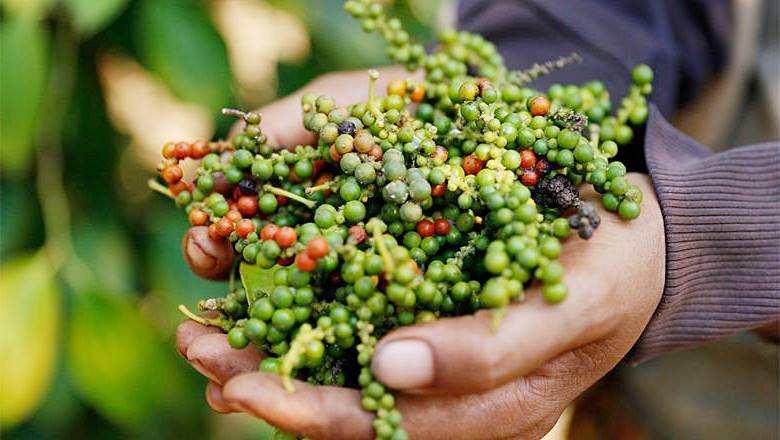November 27, 2025 | 07:01 GMT +7
November 27, 2025 | 07:01 GMT +7
Hotline: 0913.378.918
November 27, 2025 | 07:01 GMT +7
Hotline: 0913.378.918

Vietnam's pepper exports are rising sharply in value despite a significant decline in volume. Photo: Thanh Son.
Rising export pepper prices are driving significant growth in export value despite a drop in export volume. In the first seven months, Vietnam exported nearly 145,000 tons of pepper valued at USD 990 million, down 12% in volume but up 30% in value compared to the same period in 2024. The average export price over those seven months reached USD 6,841 per ton, a 47% increase year-on-year.
The decline in export volume is due to several factors, including lower domestic production. According to the Vietnam Pepper and Spices Association (VPSA), the 2025 pepper harvest in Vietnam concluded with an estimated output of 180,000 tons, down 10,000 tons from 2024. The reduction is largely due to the lack of expansion of planted area in the most recent season.
A sharp drop in pepper imports from Vietnam by the United States, Vietnam’s largest pepper market, also contributed to lower export volume. Data from the International Trade Centre (ITC) shows that in the first five months of the year, U.S. pepper imports totaled over 36,000 tons, valued at USD 273 million, down 3.3% in volume, while Vietnam’s share dropped 18% by volume.
According to Vietnam Customs, in the first seven months of 2025, Vietnam’s pepper exports to the U.S. fell 24% year-on-year to nearly 33,000 tons. Despite the drop in volume, export value rose 21% to USD 248 million, due to higher prices.
Even though the U.S. reduced purchases from Vietnam and increased imports from Indonesia and India, Vietnam remained the largest supplier, accounting for 64.4% of total U.S. pepper imports during the first five months of 2025.
The 20% U.S. retaliatory tariff on Vietnamese goods generally does not cause major concern for Vietnamese pepper exporters. Le Viet Anh, Secretary General of VPSA, notes that Indonesia faces a 19% retaliatory tariff on its pepper exports to the U.S. The 1% difference is negligible.
In the first five months of this year, Vietnam, Indonesia, India, Brazil, and China were the leading five pepper suppliers to the U.S. Only Indonesia has a lower retaliatory tariff, while Brazil and India face tariffs as high as 50%.
However, according to Phan Minh Thong, Chairman of Phuc Sinh Joint Stock Company, after the U.S. officially imposed retaliatory tariffs, U.S. importers began reassessing consumer purchasing power, given projected price increases with added tax, which has slowed shipments to the U.S.
This shows a shift from competing through volume to competing through quality and added value, in which Vietnam maintains a certain advantage thanks to its reputation and position in the market.
Another challenge is persistent logistics costs, especially maritime freight to the U.S., making it harder for Vietnamese pepper to remain price-competitive against regional rivals. Nonetheless, exporters regard this as a short-term difficulty, since many U.S. buyers still highly value Vietnam’s pepper for its quality, consistency, and reliable supply. Some companies have signed long-term contracts to retain customers and diversified product offerings with white pepper, fine-ground pepper, and organic pepper to increase added value and expand market segments.
Pepper exports to the U.S. in Q3 may face headwinds due to retaliatory tariffs, but the outlook is more optimistic from Q4 onward. VPSA expects U.S. orders to rise sharply in Q4 2025 and Q1 2026 as importers begin building inventory for the peak consumption season.
Although Vietnam’s pepper exports to the U.S. declined in the first half of the year, this may be a temporary adjustment phase before the new tariff regime. Vietnam’s lower tariff rate compared to Brazil and India, along with stable supply capability, lays the groundwork for a strong recovery in exports to the U.S. during the second half of 2025.
VPSA also expects global pepper prices to rise in the latter half of 2025, driven by increased demand from major markets, which will benefit Vietnam’s pepper exports.
In this context, maintaining quality, ensuring transparency in the supply chain, and strengthening the Vietnamese pepper brand will be key factors in sustaining its competitive advantage in the international market.
Based on export results over the past seven months and upcoming market forecasts, Le Viet Anh forecasts that Vietnam’s total pepper export volume this year will fall to around 220,000 tons (down from 250,000 tons in 2024). Despite the substantial drop in volume, higher prices will keep export value roughly equivalent to last year at USD 1.3 billion.
Translated by Huong Giang

(VAN) China’s cooking oil is suddenly flooding into India. It all comes down to a soybean surplus that Beijing doesn’t quite know what to do with.

(VAN) An Giang promotes supply-demand connections, standardizes quality and builds value chains, creating a foundation for sustainable bird’s nest development and aiming to expand exports.
/2025/11/24/5339-4-nongnghiep-075331.jpg)
(VAN) Recently, the conference on 'Sustainable Fisheries Linkage Chain - Tilapia for Export' took place in Tien Hai commune, Hung Yen province.
/2025/11/21/4309-2-153400_128.jpg)
(VAN) Green and low-emission rice is paving the way for Vietnamese rice to enter high-end markets, marking the beginning of a transformation journey toward greening and elevating the national rice brand.

(VAN) ‘Right to Win’ outlines a national action plan that shapes a new vision for Viet Nam’s agriculture in an era of renewal and global integration.

(VAN) Lam Dong’s farmed sturgeon output this year is expected to reach 2,300 tons, worth VND 450 billion, affirming the brand’s position on the market.

(VAN) A surge in Ukrainian egg exports, largely driven by soaring sales to the UK over the last few years, has notably pushed up egg prices on the domestic market.